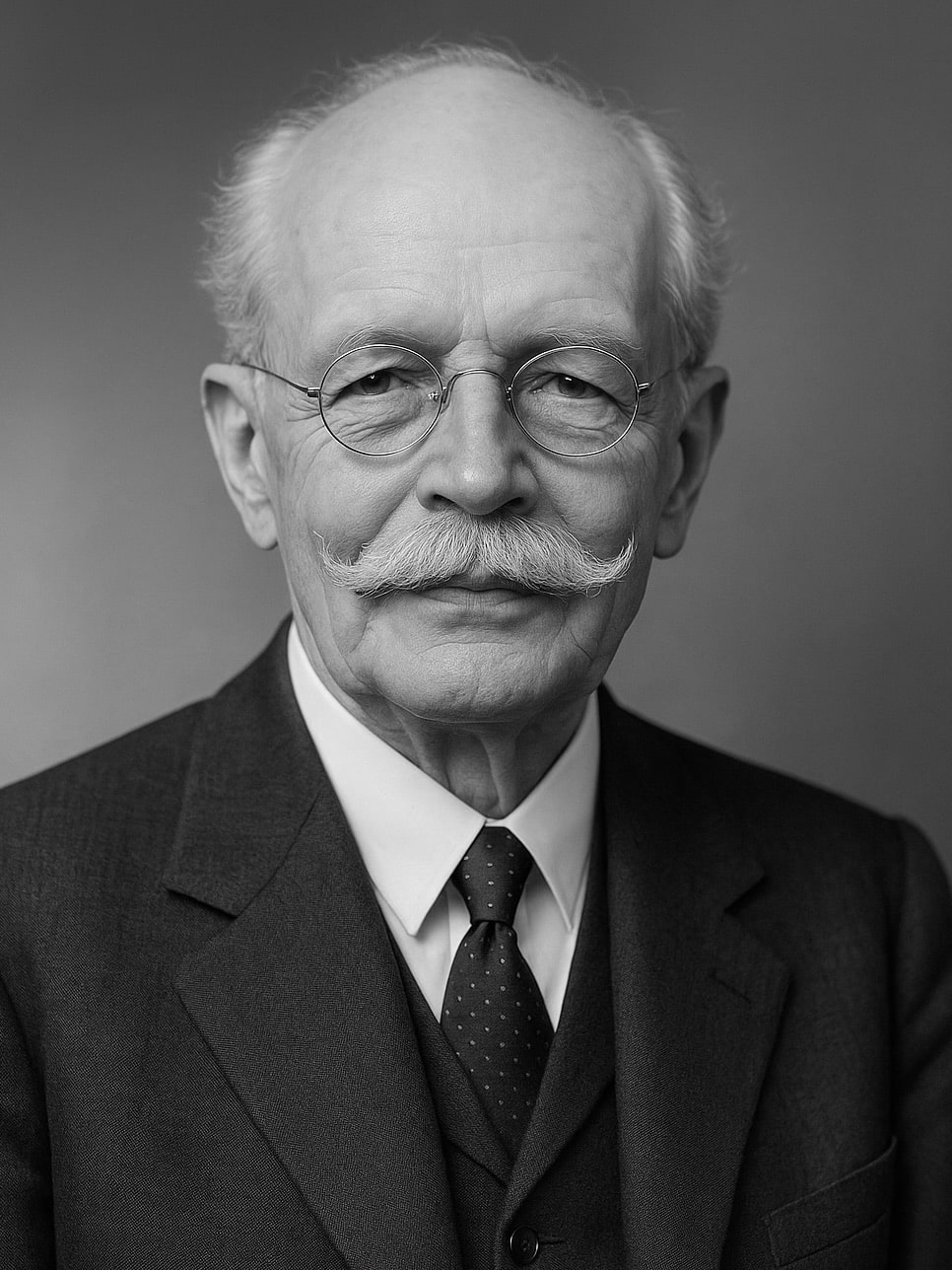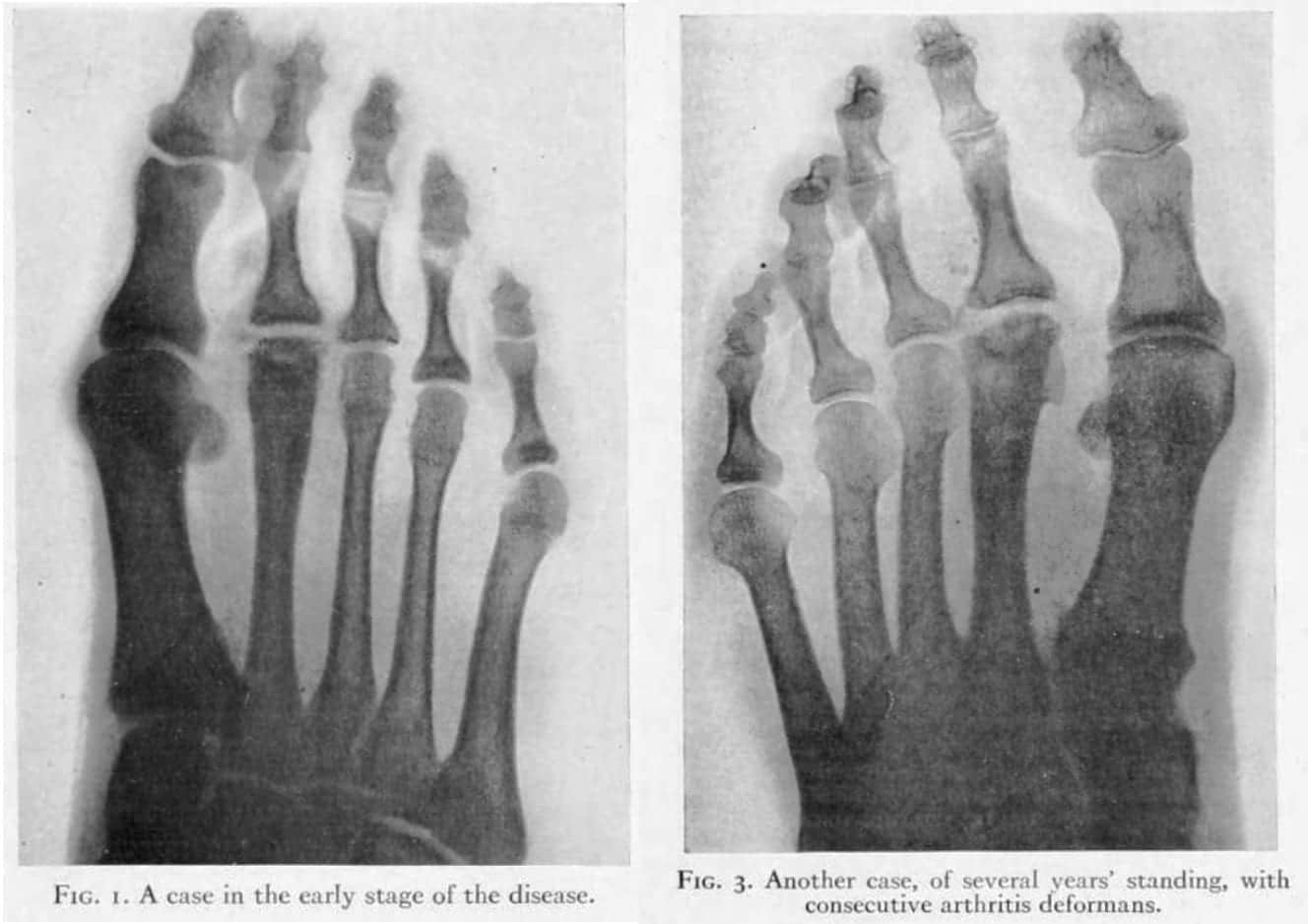Alban Köhler

Alban Köhler (1874-1947) was a German Radiologist.
Köhler’s name stands high on the list of pioneers in radiological science; his life is a long record of investigation and exemplary practice as a clinical radiological specialist.
He was a prolific writer, publishing three books within the first 10 years of the X-ray being discovered in 1895. On roentgenography of diseases of the bones (1901); the hip joint and the femur (1905), and diagnosis of pulmonary tuberculosis in children (1906).
He was one of the first to outline a practice of radiology of the heart, describing the relation of the teleroentgenogram to the orthodiagram. He devised a method to localize foreign bodies within the eye and calcific plaques in the aortic arch as well as stereoscopic and cinematographic studies of the respiratory tract.
Köhler’s most important work, which made him famous the world over, “The Borderlands of the Normal and the Early Pathological as Seen with the X-ray” or the “radiologist’s Bible” was firstpublished in German in 1910. The book ran through 8 editions with the ninth edition of his “Borderlands” partly printed when a bombing raid destroyed the publishing house and remained unfinished at the time of his death. His home in Wiesbaden, in which he had his office and radiological institute and a very important radiological library, was also destroyed by fire following a severe air attack.
Eponymously affiliated with Köhler disease (avascular necrosis of the navicular bone); the first description of the ‘Pellegrini-Stieda‘ lesion; and Köhler disease II (Freiberg infraction)
Biography
- Born on March 1, 1874 in Petsa, Thüringen
- 1899 – Completed medical doctorate having studied in Freiburg, Erlangen, and Berlin
- 1899-1902 Studied surgery and pathology under Christian Georg Schmorl (1861-1932) in St. Joseph’s Hospital, Wiesbaden.
- 1903 – Radiologist in Wiesbaden
- 1905 – Co-Founder of the Deutsche Röntgengesellschaft eV [Specialist society of German radiologists] with Albers-Schönberg
- 1912 – President of the 8th Roentgen Congress in Berlin
- 1913 – Professor of Radiology in Wiesbaden
- 1933 – Hermann Rieder medal
- Died on February 26, 1947 in Wiesbaden
Medical Eponyms
Köhler-Pellegrini-Stieda lesion (Pellegrini-Stieda disease)
Ossified post-traumatic lesions at (or near) the medial femoral collateral ligament adjacent to the margin of the medial femoral condyle. Alban Köhler reported a case of a 56-year-old male who injured his knee during piling of wood (1903, published 1905)
56 jähr. Mann. Vor 4 Jahren beim Holzaufstapeln verschüttet. Verrenkung des Hüftgelenks, Kontusion des Kniegelenks… seither keine Beschwerden in der Hüfte, aber immer im Knie, wenig beim langsamen Gang, Stechen beim schnelleren Gehen und Tragen von Lasten.
Radiogramm: Am aüsseren Condylus (im Schatten) knopfförmige kompakte Hervorwölbung, ebenso aussen an Tibia. Am inneren Condylus oben am Übergang in den Schaft im Schatten der Weichteile ein kleiner flacher dunkler Schatten, im Röntgenogramm gerade oben noch zu erkennen, der nur einer bindegewebigen Ossifikation entsprechen kann.
Köhler Plate VII, Fig 12 p140
56 year old man. Injured 4 years ago whilst piling wood. Sprained hip and contusion of the knee joint … since then no complaints in the hip, but ongoing pain in the knee, minimal with slow walking, but stabbing when walking at pace, or carrying loads.
Radiograph: At the outer condyle (in the shadow) a button-shaped, compact protrusion, similarly at the outer Tibia. At the inner condyle, up at the transition to the shaft, in the shadow of the soft tissue, a small, flat, dark shadow, only just discernable on the image, which must correspond to a connective tissue ossification.
Köhler Plate VII, Fig 12 p140

Köhler disease I (1908)
Rare, self-limiting, avascular necrosis (osteochondrosis) of the navicular bone in children. First described by Köhler in 1908 in his MWW article Uber eine häufige, bisher anscheinend unbekannte Erkrankung einzelner kindlicher Knochen [About a common, so far apparently unknown disease of individual children’s bones]
Es handelte sich um Knaben im Alter von 5-9 Jahren (..) Alle drei Patienten klagten über mehr oder weniger heftige Schmerzen in der Gegend des Os naviculare (…) Die Röntgenuntersuchung ergab einen recht eigenartigen (…) Befund. Ueberall zeigte sich das Os naviculare in die Augen fallend erkrankt, während alle anderen Knochen des Fusses einen normalen Anblick boten. Das Navikulare war in vierfacher Beziehung verändert, und zwar in seiner Grösse, seiner Gestalt, seiner Architektur und seinem Kalkgehalt.
Der Krankheitsverlauf zog sich auf 2-3 Jahre hin (…) es erfolgte Heilung (…) nicht nur im klinischen Sinne, sondern wie die Röntgenbilder anzunehmen zwingen, auch in anatomischem Sinne. Die Prognose des Leidens ist also durchaus günstig zu stellen.
In question were young lads aged 5-9 years old. All patients complained of more or less severe pains in the region of the navicular bone. The Röntgen examination demonstrated a most peculiar finding. Everywhere the navicular bone appeared diseased, whilst all other bones of the foot presented normally. The navicular was changed in four aspects, namely its size, shape, architecture, and calcification.
The disease took its course in 2-3 years (…) healing was evident(…) not only in the clinical sense, but also in the anatomical sense, as the X-rays force us to acknowledge. The prognosis of this suffering is therefore quite favourable.

Freiberg-Köhler disease [Köhler disease II] (1915, 1920)
Osteochondrosis of the metatarsal heads (typically the 2nd metatarsal head) characterized pathologically by subchondral bone collapse, osteonecrosis, and cartilaginous fissures.
Köhler first described in his book ‘Grenzen des Normalen und Anfänge des Pathologischen im Röntgenbilde‘ in 1915; and later in greater detail in 1920 at the 11th congress of the German Roentgen Ray Society (published 1923)
Am 2. Metatarso phalangeal-Gelenk kommt eine äusserst eigenartige Erkrankung vor, die, soviel Verfasser weiss, in ihrer Eigenart in der Literatur bisher nirgends gewürdigt worden ist. Es handelt sich um eine Abflachung oder Abplattung der Gelenkfläche des Köpfchens des betreffenden Metatarsus, die manchmal gelockert bez. etwas abgehoben zu sein scheint; jedenfalls sieht man mitunter, bei den anscheinend frischeren Fällen, einen infraktions- oder frakturartigen 1-2mm breiten, durchlässigen Zwischenraum (…)
Äusserst merkwürdig ist, dass die ganze distale Hälfte des befallenen Metatarsus distalwärts gleichmässig an Umfang zunimmt.
At the 2nd metatarso-phalangeal joint, a most peculiar disease may arise, which, to the knowledge of the author, has not been honoured in literature so far. It is a flattening, or squashing of the articular surface of the head of the affected metatarsal, which is sometimes loosened, or apparently somewhat lifted; in any case one may see in the fresher cases, an infraction- or fracture-like intermediary space of 1-2mm (…)
Particularly notable is that the entire distal half of the affected metatarsal broadens uniformly.

Köhler called out Freiberg for an ‘incomplete‘ description of ‘metatarsal infraction‘ lacking mention of the widening of the joint line; thickening of the shaft of the metatarsal and obliteration of the neck. Freiberg responded in 1926 acknowledging trauma unlikely to be the sole cause and the additional features as suggested by Köhler…

Major Publications
- Köhler A. Knockenerkrankungen im Röntgenbilde. 1901
- Köhler A. Die normale und pathologische Anatomie des Hüftgelenks und Oberschenkels in röntgenographischer Darstellung. Hamburg, Lucas Gräfe & Sillem, 1905 [Köhler-Stieda-Pellegrini lesion]
- Köhler A. Uber eine häufige, bisher anscheinend unbekannte Erkrankung einzelner kindlicher Knochen. Munchener medizinische Wochenschrift, 1908; 55: 1923-5 [Köhler disease I]
- Köhler A. [A Method of Deep Roentgen Irradiation without Injury to the Skin.] Archives of the Roentgen Ray, 1909; 14(5): 141–142
- Köhler A. Grenzen des Normalen und Anfänge des Pathologischen im Röntgenbilde. 1910
- Köhler A. Eine typische Erkrankung des 2. Metatarsophalangealgelenkes. Munchener medizinische Wochenschrift, 1920; 67: 1289-1290 [Typical disease of the second metatarsophalangeal joint. Translation: American journal of roentgenology. 1923, 10: 705-710] [Köhler disease II]
- Köhler A. [The Boundaries between the Normal and the Early Pathological in X-Ray Diagnosis.] British Journal of Radiology: BIR Section, 1926; 31(310): 193–194
- Köhler A. Uber Histoeische Rontgenrohren 1896-1898, Acta Radiologica, 1926; 7:1-6, 73-80
- Köhler A. Röntgenology: The Borderlands of the Normal and Early Pathological in the Skiagram. Trans. Arthur Turnbull. William Wood (1928)
References
Biography
- In Memoriam: Alban Köhler 1874–1947. Radiology 1948; 50(4): 545-546
- Freyschmidt J. [Alban Köhler (1874-1947). Assessment of a clinical radiology pioneer from the present-day viewpoint]. Rofo. 1995; 163(6): 463-8.
- Bibliography. Köhler, Alban 1874-1947. WorldCat Identities
Eponymous terms
- Thomas AMK, Banerjee AK. The History of Radiology. Oxford University Press; July 12, 2013
- Freiberg AH. The so called offense of the second metatarsal bone. Journal of bone and joint surgery, 1926; 8: 257-61 [Köhler disease II]
- Gomez A, Cadogan M. Eponymythology of foot injuries. LITFL
- Cadogan M. Köhler disease. Eponym A Day. Instagram
[cite]
Resident medical officer in emergency medicine MB ChB (Uni. Dundee) MRCS Ed. Avid traveller, yoga teacher, polylinguist with a passion for discovering cultures.

